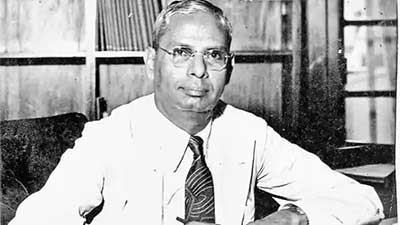Relevance: GS-3: Indian Economy and issues relating to planning, mobilization, of resources, growth, development and employment; Government Budgeting.
Relevance: GS-1: Post-Independence Consolidation
Key phrases: Fiscal capacity, rapid industrialization, Banks Nationalisation, Green Revolution, diversified industrial sector, foreign exchange, 1991 economic reforms, domestic savings, foreign exchange
Why in News?
- India completes 75 years as an independent nation this August. The long journey since 1947 has had its inevitable successes, failures and disappointments. The fiscal history of the past 75 years tells us a fascinating story.
Independent India’s first full budget was presented by R.K. Shanmukham Chetty (Interestingly he was not from Congress)
Highlights:
- Independent India began its development journey with very weak fiscal
capacity.
- The amount of tax collected by the Indian state as a proportion of its economic output was abysmally low.
- More than half of all annual tax revenues came from direct taxation of individual incomes and company profits.
- The narrow tax base as well as conservative budgeting gave the government very few financial resources to spend.
- The budget deficit in 1948 was minimal.
- Total expenditure under the budget was earmarked at Rs 197.39 crore, out of which approximately Rs 92.74 crore (or 46 percent) was allocated for Defence Services.
- The then strategy of rapid industrialization led by the state
couldn’t be based on such a weak fiscal base.
- Tax rates were increased.
- Higher fiscal deficits were funded by new money created by the Reserve Bank of India.
- Foreign aid was needed, since domestic financial resources were not enough to fund the government’s plans.
- Fiscal deficits were still modest compared to what India experienced after the 1980s.

The first Indian Budget was presented by James Wilson on February 18, 1869. Wilson, whose designation was Finance Member of the India Council that advised the Indian Viceroy, was also the founder of The Economist and described by Karl Marx as an "economical mandarin of high standing".
- Economic policy was severely constrained by shortages in foodgrain supplies, domestic savings and foreign exchange.
- However, a lot had changed by 1972. Fiscal capacity had almost
doubled in terms of the tax/GDP (gross domestic product) ratio.
- Much of that now came from indirect rather than direct taxes, which meant that the Indian tax system was most regressive.
- Two of the three big macroeconomic constraints began to get loosened
by the time India was celebrating 25 years of independence.
- The Green Revolution had helped ease the food constraint. India became self-sufficient in food.
- The domestic savings constraint was loosened from the 1970s.
- Then Finance minister YB Chavan said in his 1972 budget speech that higher deposit mobilization by the banks nationalized in 1969, Life Insurance Corp and provident funds has “greatly facilitated market borrowings" by the government.
- However, with these steps, very little money was left for the country’s private sector.
- The money being soaked up by planners was not being used well either.
- India had by then built a diversified industrial sector, though an inefficient one.
- Chavan spoke about shortages in steel, fertilizers, power and agricultural raw materials.
- Many capital goods and intermediate goods sectors were operating below capacity.
- There was still not enough foreign exchange to import goods that were in short supply.
- India had enough foreign exchange to cover only 2.9 months of imports.
- Cut to 1997:
- The 1991 economic reforms reconnected India with the world economy. The 1997 budget has now gone down in history because of its new policy initiatives as well as tax cuts.
- Often dubbed as the “Dream Budget,” the budget, saw several economic reforms introduced in India including lowering of income tax rates, removal of the corporate tax surcharges, and reduction of corporate tax rates.
- The budget also saw the introduction of the Voluntary Disclosure of Income Scheme (VDIS).
- The three old macro constraints on Indian economic policy—
inadequate domestic savings, shortages of wage goods such as food, and the
unavailability of enough foreign exchange for imports—had eased by the late
1990s.
- The situation on all three fronts has further improved over the past 25 years.
- There were new constraints on the horizon. These were energy,
infrastructure and institutional quality.
- P. Chidambaram touched on some of these challenges in his 1997 budget speech.
- The tax reforms of the 1990s also helped push up the contribution of direct taxes in total tax collections. In other words, the Indian tax system became more progressive.
- The fiscal deficit would continue to be uncomfortably high by international standards.
- Finance Minister, N. Sitharaman will present her new Union budget at
a time when the economy is recovering from the covid shock.
- The recovery in domestic demand is still uneven, inflationary pressures are building up, the global economy is preparing for higher interest rates and crude oil prices are close to their highest level in seven years.
Conclusion:
- There is also a lesson to be taken from the past 75 years. India’s
economy has broken free of many of its old structural constraints.
It now faces new constraints.
However, one unchanging fiscal fact is that the Indian state continues to be underfunded. The tax/GDP ratio, net of what the Centre shares with states, has barely moved over the past 30 years.
Increasing it, so that the state’s growing infrastructure, development, subsidy and welfare commitments are funded, is a looming challenge.
Source: Live Mint
Mains Question:
Q. India has come a long way in overcoming the old macro constraints on Indian economic policy i.e., inadequate domestic savings, shortages of wage goods, and the unavailability of enough foreign exchange for imports. Comment. What in your views are the present macro constraints in Indian Economy? (250 Words)







